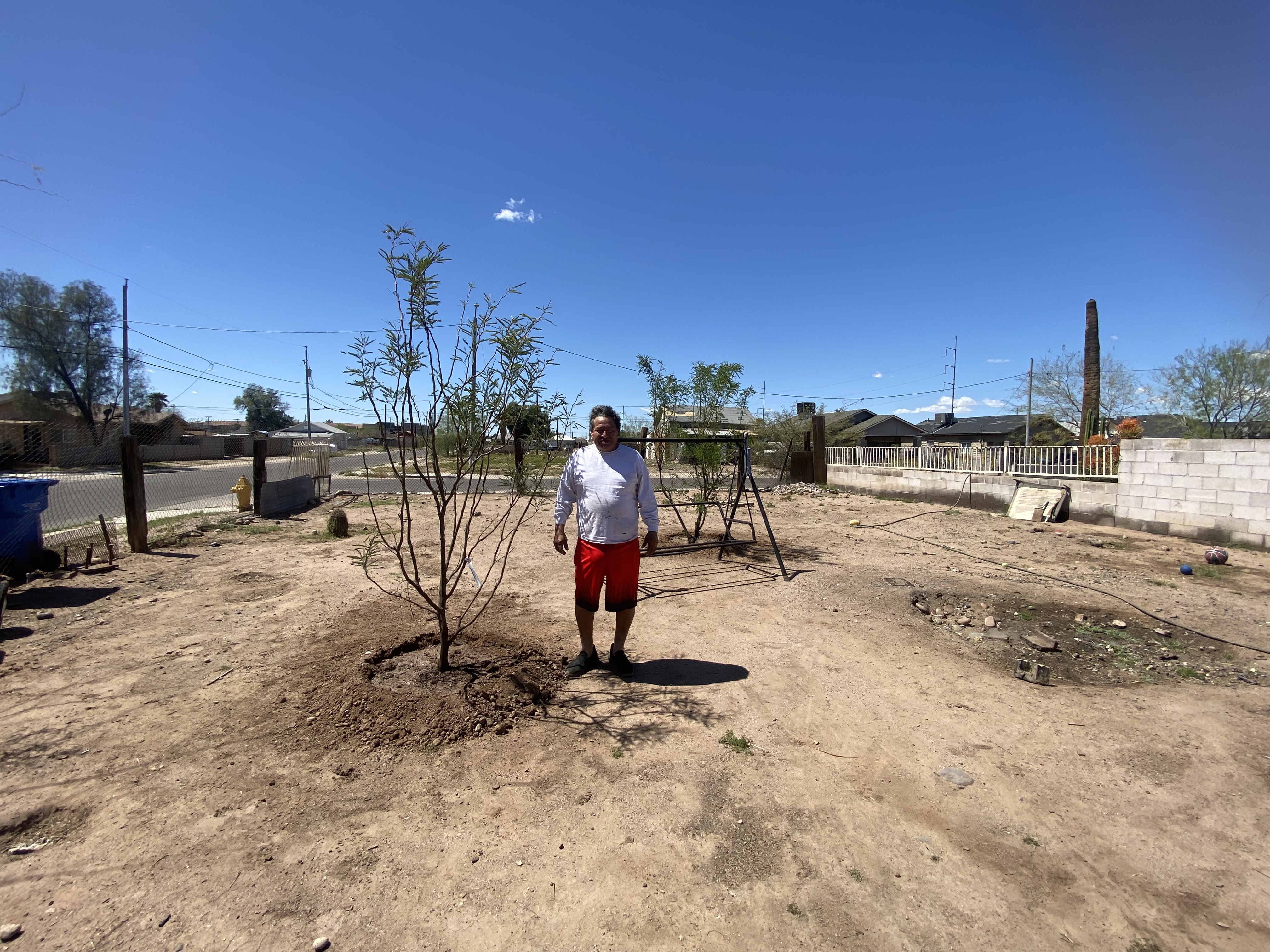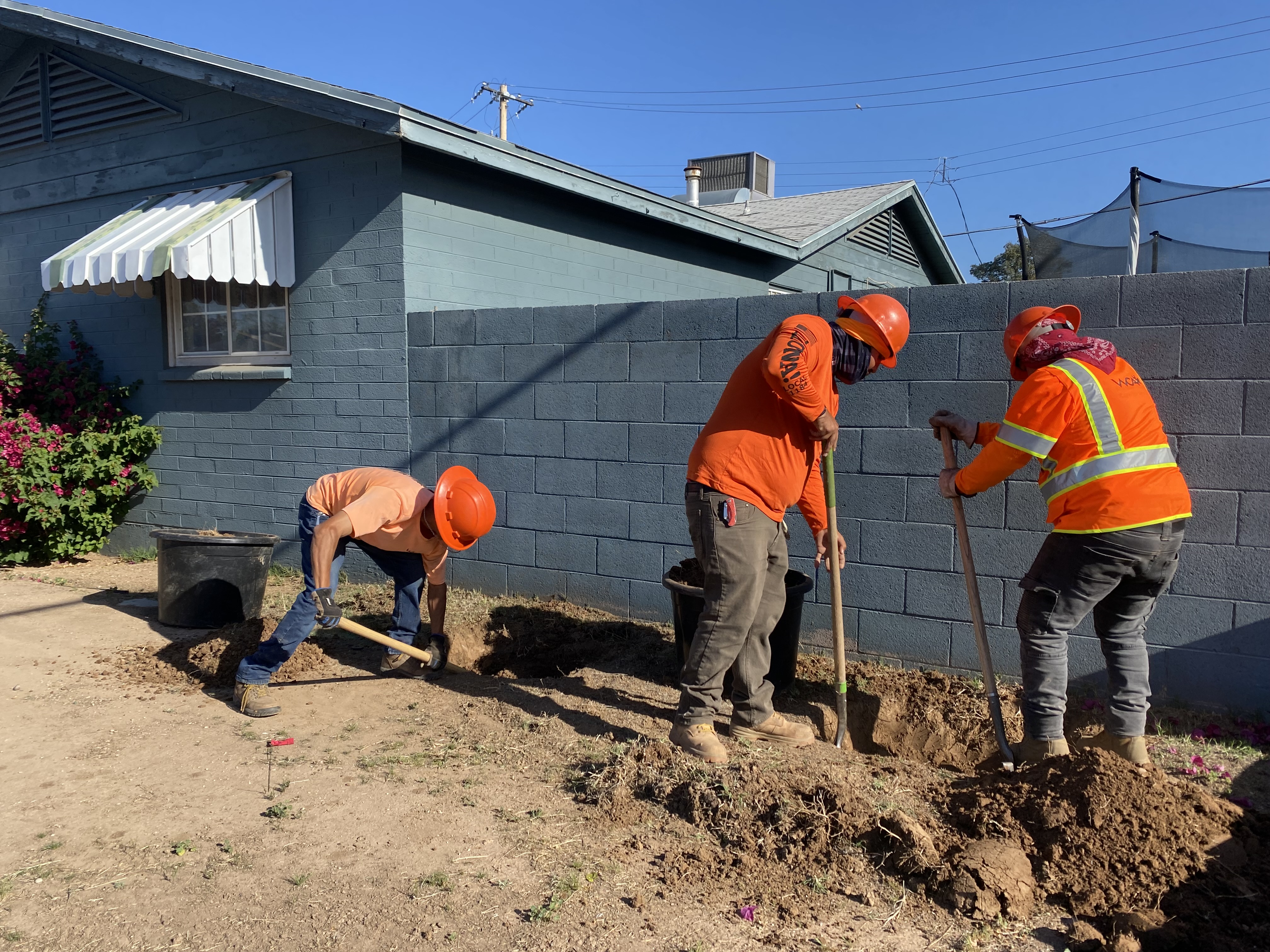Expanding Tree Canopy and Shade Structures to Protect Vulnerable Communities from Extreme Heat
Phoenix, AZTo help communities most affected by extreme heat, Phoenix’s City Council approved the allocation of $6 million ARPA funds in June 2022 to support the Residential Tree Equity Accelerator and Trees and Shade for Schools initiatives to be implemented by the Office of Heat Response and Mitigation (OHRM). By creating more natural and built shade structures in schools and neighborhoods in partnership with community members, the program aims to build stronger, more resilient communities. Lora Martens, the Urban Tree Program Manager for OHRM, explains that their goal is that “tree planting catalyzes communities and empowers them to advocate for more work like this on their behalf. I see our job as both planting trees and building community.”
Why this investment?
The summer of 2020 was one of Phoenix’s hottest summers documented, and in the last five years, almost 1,900 people have died from heat related deaths, with thousands needing emergency medical treatment. American Forests’ Tree Equity Score for Phoenix illustrates that communities with more than 80 percent residents of color have on average 45 percent less tree canopy than predominantly white neighborhoods, and the low-income neighborhoods have 36 percent less tree canopy than high-income areas. Mary Wright, the Built Environment Specialist for OHRM points out the strong correlation between trees and income. “The research shows that surface temperature, which is also correlated with tree coverage, [is] correlated with historic redlining,” Wright says.
Community groups and individuals, such as Chispa, an offshoot of the League of Conservation Voters that focuses on environmental justice for Latinx and communities of color; Trees Matter, an environmental education nonprofit; and the Arizona Sustainability Alliance, a non-partisan group committed to protecting the environment and promoting sustainable living through action and advocacy, are actively advocating for the implementation of the programs and for the work being done by OHRM.

What is this investment?
Phoenix is the first city in the United States to set a public goal for achieving tree equity by 2030 through a partnership with American Forests. The Residential Tree Equity Accelerator and Shade for Schools programs will work toward that goal. By planting trees and ensuring their growth, the City aims to nearly double the tree canopy cover in underserved communities.
OHRM set an aspirational goal of planting trees at 75 schools and in 15 neighborhoods with very low tree equity scores. To achieve that goal, they are offering three types of grants to organizations planning projects in low-income neighborhoods based on their Qualified Census Tracts or QCT status:
- Community Canopy, which provide trees, services, and support for tree plantings at homes, apartments, and community sites;
- Canopy for Kids, which provides trees, services, and education for plantings to public schools, nonprofit schools, and youth-focused nonprofits; and
- Shade for Students, which provides built shade structures for public schools, nonprofit schools, and nonprofits that are youth focused.
In addition to the trees and planting services, individuals and neighborhood groups receive irrigation timers, a 100 ft. hose, and a moisture meter to help care for their trees in the early stages, and OHRM plans to pay for maintenance if needed. Residents also receive educational pamphlets that cover watering, maintenance, and information about the tree. OHRM lets the community and residents decide how the trees are planted and whether it is done by the department, the community, or by themselves.
Due to the hot desert climate of Phoenix and QCT schools’ lack of resources, OHRM has been working to get adequate irrigation systems installed or maintained to ensure the longevity of the new trees planted. Schools can apply for a total of $75,000, with an average of $1,300 per tree. OHRM encourages the sites to use the funds to make vital infrastructural improvements and to work with nonprofits to develop curriculum in their schools to engage students and the community in planting.
Centering equity in the program
Getting the word out to non-English speaking residents has been a priority for OHRM. The department has distributed written material, applications, and presentations in both English and Spanish. The City does not provide translation services to all departments, so OHRM has had to be resourceful to ensure an equitable distribution of information by getting support from Spanish speaking staff in the department or outside firms for translation.
Unlike traditional grant models used for the schools and other operations in Phoenix that require sites to purchase materials to be reimbursed by the City, individuals and households receive the trees and planting services directly at no cost to them. Structuring the program in this way was important to OHRM to remove barriers to this vital infrastructure project. Wright says that this helped move the needle in terms of making the program more equitable, and Martens explains that OHRM thought that would be prohibitive for an individual or group to have to put up $5000. “We don’t want there to be a barrier to receiving trees,” Marten says.
OHRM views outreach as crucial to its success, but also challenging. As many of the communities they seek to reach historically have not received much attention from the City, some are skeptical of the service and potential costs. Wright describes the challenge of making connections in neighborhoods. “I think people think it’s almost too good to be true. We work to make sure that people know that everything is taken care of.”

Outcomes to date
As of February 2024, there have been 75 applicants to the Community Canopy program and 9 approved applications for the Canopy for Kids program. Shade for Students, which closed applications in early February 2024, approved 18 grant applications for 43 shade structures.
Toward transformative change
OHRM is working to ensure they have the resources to sustain the program until they attain their tree equity goal. In September 2023, the program was awarded $10 million from the Inflation Reduction Act to continue their tree planting efforts for another 5 years. The department is still looking for long-term funding for the build shade program.
In making recommendations for other jurisdictions, OHRM suggests emphasizing local businesses to support programming. Spending money locally on local products for the program has been a persistent goal for the department. For OHRM, this looks like contracting with local wholesale nurseries, hiring local videographers, and commissioning a local graphic designer to create a T-shirt for the program. OHRM also stresses partnerships with existing community organizations, especially those who have precedent working in the communities they wish to serve.
